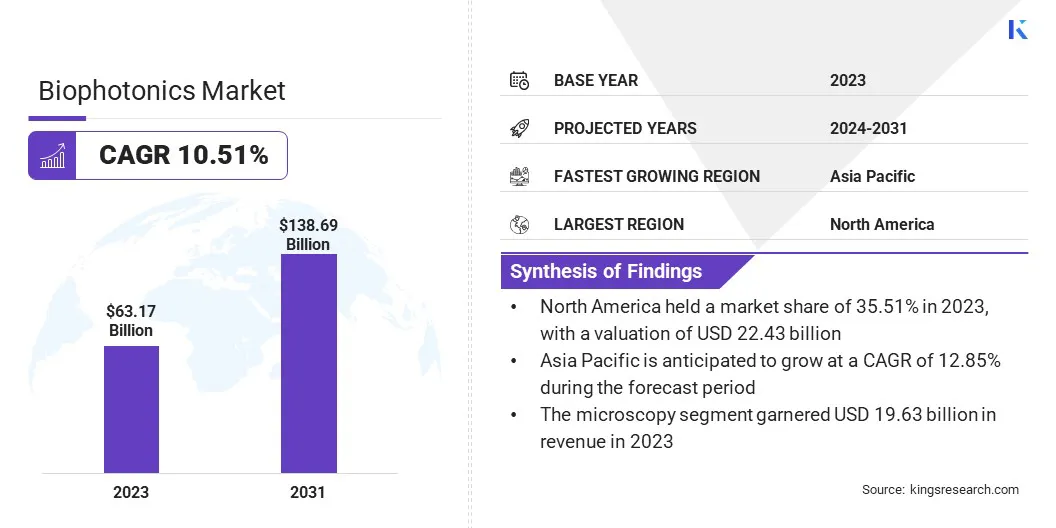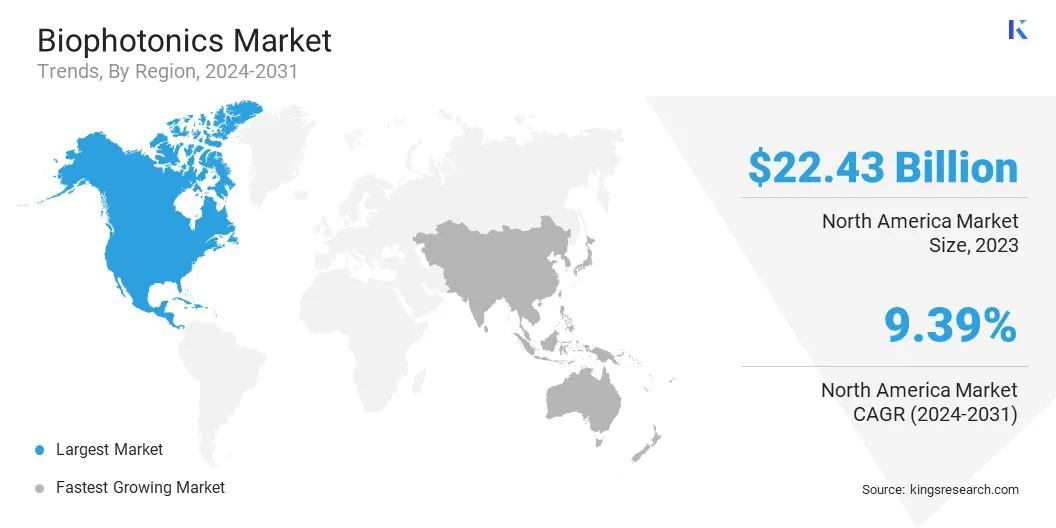Biophotonics Market Size
The global Biophotonics Market size was valued at USD 63.17 billion in 2023 and is projected to reach USD 138.69 billion by 2031, growing at a CAGR of 10.51% from 2024 to 2031. The increasing demand for non-invasive diagnostic and therapeutic techniques is reshaping the global market by driving innovation toward safer and more patient-friendly medical solutions. This trend fuels the development of advanced biophotonics technologies, thereby expanding their adoption across various medical fields and propelling market growth. In the scope of work, the report includes products offered by companies such as Hamamatsu Photonics K.K., Carl Zeiss AG, Olympus Corporation, PerkinElmer, Inc., Becton, Dickinson and Company (BD), Thermo Fisher Scientific Inc., Bruker Corporation, Nikon Corporation, Leica Microsystems GmbH, Agilent Technologies, Inc. and Others.
Moreover, the increasing prevalence of chronic diseases has led to a significant shift toward advanced diagnostic and therapeutic methods. Biophotonics technologies offer non-invasive, sensitive, and rapid solutions for early disease detection and personalized treatment monitoring. Key industry players are dedicating substantial resources to research and development efforts to enhance the capabilities and accessibility of biophotonics tools.
Additionally, the growing emphasis on preventive healthcare strategies amplifies the demand for innovative biophotonics solutions. Biophotonics contributes to improving patient outcomes by addressing the pressing need for timely intervention in chronic diseases, and ultimately enhancing the quality of life for millions worldwide.
Biophotonics is an interdisciplinary field that merges biology and photonics, focusing on the interaction between light and biological materials. Its applications cover various domains, including medical imaging such as optical coherence tomography for retinal imaging, spectroscopy, and microscopy. Regulatory aspects play a crucial role in ensuring safety and efficacy, with bodies such as the Food and Drug Administration (FDA) overseeing approval processes for biophotonics devices. These devices must meet stringent standards before entering the market.

Analyst’s Review
In the competitive biophotonics market, companies may thrive by investing in R&D to innovate new technologies and collaborate with academic institutions and industry partners. Forming strategic partnerships with healthcare providers, pharmaceutical companies, and technology firms expands market reach.
Moreover, regulatory compliance and certifications, such as FDA approval, enhance product credibility and market acceptance. Proactive engagement with regulatory agencies facilitates compliance and streamlines product commercialization. The biophotonics market is set to witness robust growth, mainly driven by technological advancements and increasing healthcare demands. Emerging markets such as Asia-Pacific offer promising growth opportunities due to rising healthcare investments.
Additionally, the integration of artificial intelligence, machine learning, and big data analytics may revolutionize diagnostics, personalized medicine, and therapeutic interventions. Effective use of growth strategies and regulatory opportunities may lead to sustained growth in the dynamic biophotonics market.
Biophotonics Market Growth Factors
Technological advancements in photonics, imaging, and spectroscopy are pivotal factors propelling the growth of the biophotonics market. Advancements in these areas have revolutionized the capabilities of biophotonics devices, enabling more precise, sensitive, and non-invasive diagnostic and therapeutic solutions. Innovations in laser technology have facilitated the development of advanced imaging modalities such as multiphoton microscopy, which enhances cellular imaging with subcellular resolution.
Moreover, improvements in spectroscopic techniques such as fluorescence spectroscopy have enabled real-time analysis of biological samples for disease detection. For instance, in February 2023, research funded by the National Institutes of Health (NIH) led to the development of a new type of MRI scan that can image the brain at much higher resolutions. These advancements drive market expansion by meeting evolving healthcare needs while fostering innovation in biophotonics.
Moreover, government initiatives and funding for biophotonics research and development foster market expansion. These initiatives aim to stimulate innovation, improve healthcare outcomes, and enhance competitiveness in the global market. By providing financial support, grants, and incentives to academic institutions and research organizations, governments encourage the advancement of biophotonics technologies. For instance, the 117th Congress of United States held in 2022, passed a Chips and Science Act. This act allocated USD 52.7 billion for semiconductor research and development, with a portion dedicated to supporting biophotonics infrastructure and workforce development.
Biophotonics Market Trends
The growing trend of miniaturization and the development of wearable biophotonics devices are set to transform the healthcare landscape in the foreseeable future. These compact, non-invasive devices enable real-time monitoring of vital signs and biomarkers, empowering proactive healthcare management and early disease detection. With advancements in sensors and wireless connectivity, wearable biophotonics devices are expected to become more widespread, offering personalized and accessible healthcare solutions.
Recent advancements in optogenetics have brought a revolution in biophotonics applications. By utilizing light-sensitive proteins to precisely manipulate cellular activity, optogenetics enables targeted interventions in living organisms with unparalleled precision. This technology holds immense potential for understanding complex biological processes, developing innovative therapies, and advancing fields such as neurobiology and synthetic biology. Ongoing research continues to push the boundaries of optogenetics, positioning it to reshape medical treatments and drive scientific discoveries in the forthcoming years.
Segmentation Analysis
The global biophotonics market is segmented based on application, technology, end use, and geography.
By Application
Based on application, the market is segmented into surface imaging, inside imaging, see-through imaging, microscopy, biosensors, medical lasers, and spectromolecular technologies. The microscopy segment led the market in 2023, reaching a valuation of USD 19.63 billion. The versatile applications of microscopy across various industries such as healthcare, life sciences, material science, and nanotechnology propel the growth of this segment. Microscopy enables high-resolution imaging of biological samples and materials, thereby driving its widespread adoption and market dominance.
For instance, scientists at the University of California, Berkeley, developed a deep-learning-based approach to enhance the resolution of super-resolution microscopy. This method, called DeepSTORM3D, significantly improves the 3D reconstruction of biological structures, offering clearer insights into cellular processes.
By Technology
Based on technology, the market is bifurcated into in-vivo and in-vitro. The in-vivo segment secured the largest revenue share of 65.17% in 2023 due to its critical role in biomedical research, diagnostics, and therapeutic interventions. In-vivo biophotonic technologies enable real-time observation and analysis of biological processes and offer insights into disease progression, treatment efficacy, and physiological responses.
For instance, researchers at the Massachusetts Institute of Technology (MIT) developed novel in-vivo optogenetic tools for selectively manipulating and recording neural activity in freely behaving animals. These tools have potential applications in treating neurological disorders. With increasing demand for non-invasive and personalized healthcare solutions, the in-vivo segment continues to expand steadily.
By End Use
Based on end use, the market is classified into medical diagnostics, medical therapeutics, and non-medical applications. The non-medical applications segment is poised to witness significant growth at a CAGR of 10.81% through the forecast period. This growth is primarily fueled by increasing applications of biophotonics in non-medical fields such as food technology. In January 2024, scientists at Huaiyin Institute of Technology, China, introduced a sensor that utilizes surface plasmon resonance (SPR) for rapid detection of foodborne pathogens. This innovative technology provides a faster and more reliable alternative to traditional quality control methods. These advancements highlight the potential of biophotonics in addressing critical challenges beyond medical diagnostics and therapeutics, thus leading to increased adoption across various industries.
Biophotonics Market Regional Analysis
Based on region, the global biophotonics market is classified into North America, Europe, Asia-Pacific, MEA, and Latin America.

The North America Biophotonics Market share stood around 35.51% in 2023 in the global market, with a valuation of USD 22.43 billion. This dominance is attributed to robust investments in research and development, a well-established healthcare infrastructure, and extensive adoption of advanced technologies across diverse industries.
For instance, in February 2023, the National Science Foundation (NSF) awarded USD 25 million to establish a new biophotonics Science and Technology Center (BSTC) within the US. Additionally, strategic collaborations between academic institutions, research organizations, and industry players propelled market growth in North America.
Asia-Pacific is estimated to experience significant growth at a CAGR of 12.85% over the review timeline. This growth is mainly propelled by increasing investments in research and development, expanding healthcare infrastructure, and rising adoption of advanced biophotonics technologies across various sectors. In March 2024, a joint study by the National University of Singapore (NUS) and the Agency for Science, Technology, and Research, reported the development of a novel biophotonics-based platform for early cancer detection. This platform utilizes photoacoustic imaging (PAI) and artificial intelligence (AI) to non-invasively identify and characterize tumors at an early stage.
Additionally, the burgeoning population and rising healthcare awareness in the region are anticipated to contribute to favorable market conditions, strengthening its position in the global biophotonics market.
Competitive Landscape
The global biophotonics market report will provide valuable insight with an emphasis on the fragmented nature of the industry. Prominent players are focusing on several key business strategies such as partnerships, mergers and acquisitions, product innovations, and joint ventures to expand their product portfolio and increase their market shares across different regions. Strategic initiatives, including investments in R&D activities, the establishment of new manufacturing facilities, and supply chain optimization, could create new opportunities for market growth.
List of Key Companies in the Biophotonics Market
- Hamamatsu Photonics K.K.
- Carl Zeiss AG
- Olympus Corporation
- PerkinElmer, Inc.
- Becton, Dickinson and Company (BD)
- Thermo Fisher Scientific Inc.
- Bruker Corporation
- Nikon Corporation
- Leica Microsystems GmbH
- Agilent Technologies, Inc.
Key Industry Developments
- January 2024 (Partnership): Biocare Medical and Molecular Instruments joined forces to develop automated bioimaging technology, aiming to enhance efficiency and accuracy in pathology laboratories. This partnership combined Biocare's expertise in developing reagents and assays for cancer diagnostics with the advanced automated microscopy platform of Molecular Instruments. The collaboration streamlined workflows, improved diagnostic capabilities, and ultimately contributed to better patient outcomes through more precise and efficient pathology analysis.
- January 2024 (Partnership): GE Healthcare and MedQuest Associates partnered to advance imaging centers across the US. The collaboration aimed to enhance patient care and operational efficiency by leveraging GE Healthcare's advanced imaging technologies and MedQuest's expertise in outpatient imaging management. Through the deployment of innovative solutions and workflow optimization, the initiative sought to improve access to high-quality imaging services, thereby benefiting patients and healthcare providers across the nation.
The Global Biophotonics Market is Segmented as:
By Application
- Surface Imaging
- Inside Imaging
- See-through Imaging
- Microscopy
- Biosensors
- Medical Lasers
- Spectromolecular Technologies
By Technology
By End Use
- Medical Diagnostics
- Medical Therapeutics
- Non-medical Applications
By Region
- North America
- Europe
- France
- U.K.
- Spain
- Germany
- Italy
- Russia
- Rest of Europe
- Asia-Pacific
- China
- Japan
- India
- South Korea
- Rest of Asia-Pacific
- Middle East & Africa
- GCC
- North Africa
- South Africa
- Rest of Middle East & Africa
- Latin America
- Brazil
- Argentina
- Rest of Latin America


